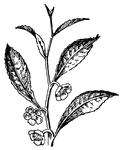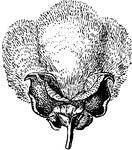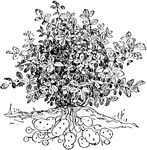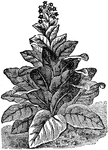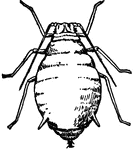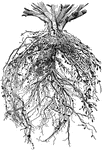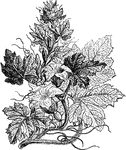
Virginia Creeper
A plant which grows upon or just beneath the surface of the ground, or upon any other surface.

Plant with Roots Pruned
"This pruning or shortening of the roots causes the production of a new set of fibres from the severed…

Lettuce
An annual plant cultivated in gardens, and which serves as a salad. There are many species, most of…
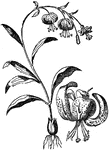
Tiger Lily
An ornamental plant of the genius lilium, characterized by an erect stem from a scaly bulb, numerous…
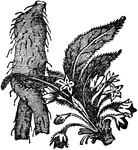
Mandrake
A plant native to America and Eurasia, and which has a narcotic poison in all of its parts.
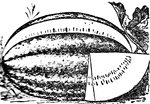
Watermelon
The fruit and plant of the vine-like herb originally from southern Africa. This flowering plant bears…
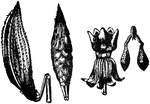
Milkweed
Any plant of the genus asclepias, of the milkweed family, so called from the milky juice that exudes…

Tree Design
Sometimes called the tree of life. Always associated with religious belief. It symbolizes Divine power…
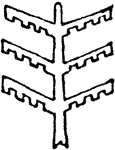
Tree Design
Sometimes called the tree of life. Always associated with religious belief. It symbolizes Divine power…
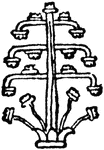
Tree Design
Sometimes called the tree of life. Always associated with religious belief. It symbolizes Divine power…
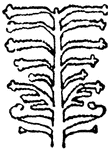
Tree Design
Sometimes called the tree of life. Always associated with religious belief. It symbolizes Divine power…
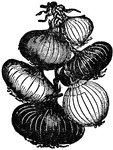
Onion
An edible bulb, produced by a biennial herb of the lily family. The plant has tubulated leaves, a pithy…

Opium
The milky juice obtained fom the unripe capsules of several species of the poppy, which is rendered…
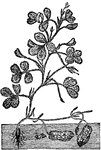
Peanut
A trailing plant of the bean family, bearing a hairy stem, small yellow flowers, and two-paired primate…

Pineapple
A tropical plant much esteemed and cultivated for its fruit. It is so named because the fruit somewhat…
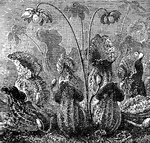
Pitcher Plants
A group of plants remarkable for having leaves or petioles formed like pitchers, and in which more or…

Radish
A fleshy plant grown extensively as a garden vegetable. It is thought to be native to India, where it…

Raspberry
A shrubby plant belonging to the same genus as the blackberry. It is cultivated extensively as a garden…

Rice
An annual cereal plant native to India, but now extensively naturalized and cultivated for its seed.
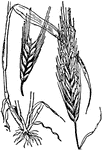
Rye
An import cereal plant. It is native to the Levant but is cultivated extensively in temperate climates,…
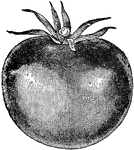
Tomato
A plant of the nightshade family, which is extensively cultivated for its edible fruit. The tomato is…

Tuberose
An ornamental bulbous plant, native to tropical America and Asia, and cultivated in gardens for its…

Turnips
A biennial plant of the mustard family, which is cultivated for its fleshy globular, edible root.
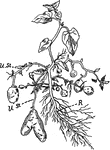
Potato Plant
This illustration shows a potato plant. The tubers are the thickened ends of the under ground stems.

Epidermis
This illustration shows a stem of a plant. e; epidermis; s, stoma; p, palisade mesophyll; ch, chloroplast;…
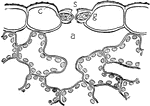
Stoma
This illustration shows a section across a stoma. The stoma is the tiny opening or pore, found mostly…

Aralia
A genus of the plant family Araliaceae, consisting of about 30 species of deciduous and evergreen trees…
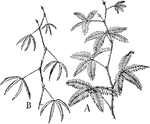
Mimosa
Figure A shows the leaf position of the light sensitive plant, Mimosa in sunlight. Figure B shows it…
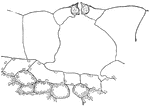
Tradescantia
This illustration shows a close up of the plant tradescantia. It shows the delicate character of the…
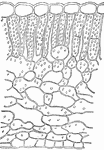
Spathyema
This illustration shows a section of the leaf of skunk cabbage, Spathyema. Note the poorly developed…
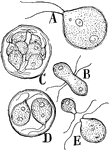
Chlamydomonas
This illustration shows the features in the life history of Chlamydomonas: A, character of the motile…
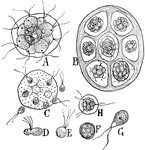
Pandorina
This illustration shows the features in the life history of Pandorina: A, a colony of plants. B, each…
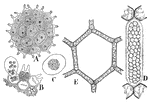
Green Algae
This illustration shows the colonial forms of unicellular green algae: A, Pediastrum, the plants of…
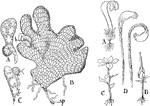
Sphagnum
This illustration shows the germination of the spore Sphagnum: A, early growth of the spore. B, later…

Selaginella
This illustration shows a common cultivated Selaginella: I, habit of the plant-s, strobili; b, a branch…

Lepidium
This illustration shows stages in the germination of the gametospore of Lepidium, sectional view: A,…

Redtop
This illustration shows a portion of switchgrass. It is a warm-season plant and it is one of the dominany…

Indian Millet
This is an illustration of the Indian Millet plant. It is native to Nevada and Utah in the southwestern…

Quatrefoil
In architecture, a piercing or panel divided by cusps or foliations into four leaves, or more correctly…



